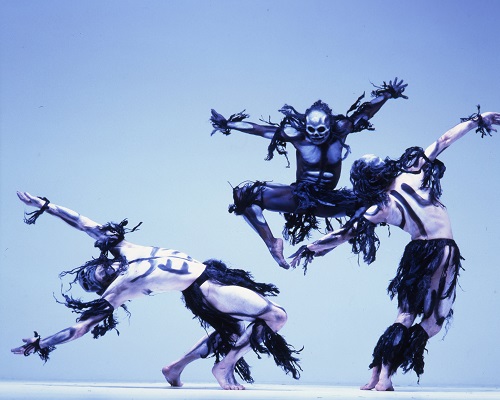 United Kingdom Rambert Tour 2016 – Tomorrow, Frames, Ghost Dances: Edinburgh Festival Theatre, Edinburgh. 24.12.2016. (SRT)
United Kingdom Rambert Tour 2016 – Tomorrow, Frames, Ghost Dances: Edinburgh Festival Theatre, Edinburgh. 24.12.2016. (SRT)

Tomorrow:
Choreography – Lucy Guerin
Music – Scanner
Lighting – Lee Curran
Frames:
Choreography – Alexander Whitley
Music – Daníel Bjarnason
Lighting – Lee Curran
Ghost Dances:
Choreography – Christopher Bruce
Music – arranged by Nicholas Mojsiejenko
Lighting – Nick Chelton
Set – Christopher Bruce
Ghost Dances was created for Rambert back in 1981. Since then, according to the company’s Artistic Director, it has become the most requested work in their back catalogue. This is their first revival of it in thirteen years and, in my first encounter with it, it’s easy to see why it has been so popular.
Chroeographer Christopher Bruce was inspired by South America’s traditional Day of the Dead. Three skeletal figures brood on an empty stage before interacting with a crowd of civilians, picking them off for death one by one. If that synopsis sounds morbid, however, then the piece is anything but. Death comes to us all, after all, and every couple or group on stage is given a joyous celebration of life before they are taken away. I enjoyed the touching love duet and solo scenes, but the ebullient ensemble with the jagged rag-doll dancing made me chuckle with pleasure; and the death that claimed them felt like a satisfying full stop rather than a tragic cutting short. The airy Latin American score helped, too, evoking a different culture that nevertheless housed people who shared the same emotions as us.
One of the reasons why Rambert have waited so long to revive Ghost Dances must, surely, be because they want to encourage new work rather than rest too long on their laurels. It’s a shame, then, that the companion pieces tonight weren’t as satisfying. Lucy Guerin’s Tomorrow was the better of the two. Based on the story of Macbeth, it divides the bare stage in two, showing two worlds that coexist but are kept rigidly separate. On one side seven black-clad dancers act out the story of the play, while on the other seven wild figures dressed in dirty white dance the witches. The witches’ mechanistic jarrings contrast with the everyday mime of the actors, who kill with easy banality while ignoring what is happening on the other side of the stage. I liked the contrast of worlds: it gave power to the storytelling and it gave the eye time to get used to the bifurcated stage picture. One of the quirks of Guerin’s design is that the story of the play is told backwards which, while it only works if you know the play, makes the climax of the dance piece Macbeth’s first/final meeting with the three witches, the only time he acknowledges their presence.
Frames didn’t speak to me at all, however. Fourteen dancers play with metal bars and construct different shapes with them, weaving in and out of one another and creating patterns both on the floor and in the air. It’s meant to be a reflection on how a production is put together, including the physical objects involved, and there is a brief parody of a ballet class in there. For me the props just got in the way, however, turning lazy when the dancers began to copy the shapes of the objects, and when they switched on the spotlights on the frames it felt like half-baked motion capture. Far better were the moments when the dancers were left to get on with it themselves, especially the moments where one man danced with a metal bar, which proved strangely hypnotic; much more so than the noisy flat-pack that cluttered the rest. Daníel Bjarnason’s music promised a lot but the dance never delivered.
Simon Thompson
The Rambert tour continues until May 2017. For full details click here.
